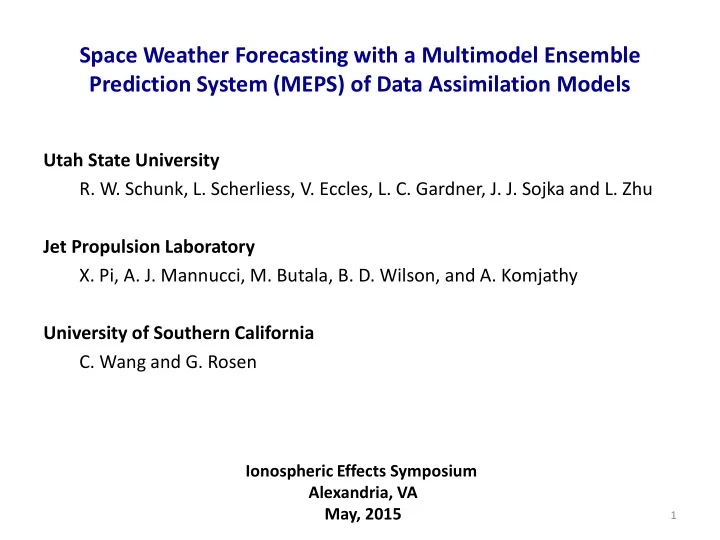

Space Weather Forecasting with a Multimodel Ensemble Prediction System (MEPS) of Data Assimilation Models Utah State University R. W. Schunk, L. Scherliess, V. Eccles, L. C. Gardner, J. J. Sojka and L. Zhu Jet Propulsion Laboratory X. Pi, A. J. Mannucci, M. Butala, B. D. Wilson, and A. Komjathy University of Southern California C. Wang and G. Rosen Ionospheric Effects Symposium Alexandria, VA May, 2015 1
MEPS Model The Multimodel Ensemble Prediction System (MEPS) covers the Ionosphere-Thermosphere-Electrodynamics (I-T-E) system and incorporates existing, first-principles-based, data assimilation models with different physics, numerical techniques, and initial conditions. MEPS allows ensemble modeling with different data assimilation models .
NASA/NSF Space Weather Modeling Collaboration Science Focus • Elucidate the fundamental physical, chemical, and coupling processes that operate in the I-T-E system for a range of actual, global-scale, space weather events , including storms & substorms. • Identify the spatial and temporal scales over which mass, momentum, and energy flow in the system. • Determine the effect that plasma and neutral gas structures (100-1000 km) have on global-scale flows.
NASA/NSF Space Weather Modeling Collaboration Applications National Hurricane Center multi- model ensemble forecast for • GAIM-GM Reconstruction hurricane Rita. • Will redo with MEPS
MEPS Data Assimilation Models GAIM-BL Mid & Low Latitudes GAIM-GM Mid & Low Latitudes GAIM-4DVAR Mid & Low Latitudes, with Drivers GAIM-FP Mid & Low Latitudes, with Drivers Mid-Low Electro-DA Ionosphere with Drivers IDED-DA High Latitudes, with Drivers GTM-DA Global Thermosphere • Global, Regional & Nested GRID Capabilities • GAIM-GM & GAIM-BL are Operational Models • Science, Specifications & Forecasts
MEPS Data Sources
MEPS Initial Simulation Plan GAIM-BL Mid & Low Latitudes GAIM-GM Mid & Low Latitudes GAIM-4DVAR Mid & Low Latitudes, with Drivers GAIM-FP Mid & Low Latitudes, with Drivers
MEPS Initial Simulation Plan • Run 4 data assimilation models independently for same case • Run with TEC data from 530 ground GPS receivers • Run with 530 ground GPS receivers & COSMIC occultation data • Run with 530 ground GPS receivers, occultation data, & 80 digisondes Goal is to see the differences in the model results and to see how the different models handle the same data type
Run the Four Data Assimilation Models with TEC data from 530 ground GPS receivers 10
NmF2 Comparison for the Storm Day IPM Differences in magnitude of the equatorial anomaly. • Some differences in longitude and width of equatorial anomaly • Four models show enhanced NmF2 in the southern hemisphere • beyond 30° latitude 11
HmF2 Comparison for the Storm Day IPM Differences in the equatorial region near 0° and 120° longitude • middle latitudes in the southern hemisphere • 12
GAIM-GM 2013 Day 76 21:00 UT TEC NmF2 hmF2 GPS GPS+occ GPS + occ + sao Storm Day
GAIM-FP 2013 Day 76 21:00 UT TEC NmF2 hmF2 GPS GPS+occ GPS + occ + sao Storm Day
GAIM-GM 2013 Day 76 21:00 UT Diff TEC NmF2 hmF2 GPS GPS+occ GPS + occ + sao Storm Day
GAIM-FP 2013 Day 76 21:00 UT Diff TEC NmF2 hmF2 GPS GPS+occ GPS + occ + sao Storm Day
Models Display Both Qualitative and Quantitative Differences • Different Background Physics-Based Models • Different Assimilation Techniques • Different Spatial and Temporal Resolutions • Different Deduced Electrodynamics Drifts • Different Deduced Neutral Winds and O/N 2 Ratios Goal is a Systematic Study to Elucidate Causes of Differences 17
Summary • MEPS ensemble modeling with different data assimilation models • Data assimilation on multiple spatial & temporal scales • Wide range of ground and space data • An important tool for studying basic physics • Can combine different data sets into a coherent picture • Fills in regions where there are no data • Can be used to study unresolved problems • New approach to specifications and forecasts
TEC Comparison for the Storm Day IPM Agreement in TEC enhancement (magnitude) • Some differences in the extension and width of equatorial anomaly • o Four models show enhanced TEC in the southern hemisphere beyond 30° lat o Extent of the enhancement 21
GAIM-GM 2013 Day 75 21:00 UT TEC NmF2 hmF2 GPS GPS+occ GPS + occ + sao
GAIM-FP 2013 Day 75 21:00 UT TEC NmF2 hmF2 GPS GPS+occ GPS + occ + sao
GAIM-GM 2013 Day 75 21:00 UT Diff TEC NmF2 hmF2 GPS GPS+occ GPS + occ + sao
GAIM-FP 2013 Day 75 21:00 UT Diff TEC NmF2 hmF2 GPS GPS+occ GPS + occ + sao
Recommend
More recommend